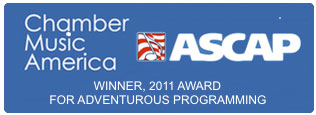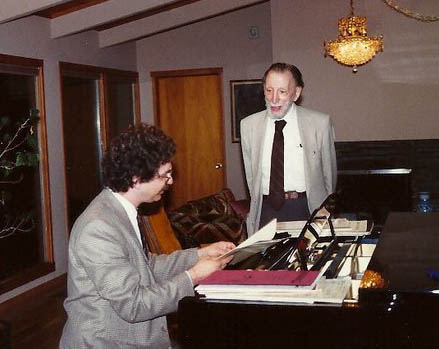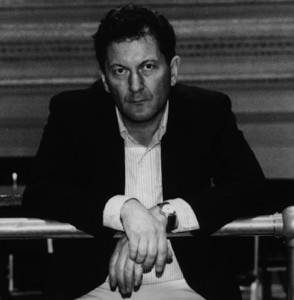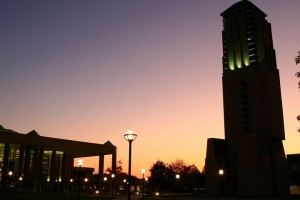 The CMA/ASCAP Awards for Adventurous Programming will be presented at the 33rd Chamber Music America National Conference on Saturday, January 15, 2011 at the Westin New York at Times Square (207 W. 43rd Street) in New York City. Frances Richard, vice president and director of concert music, American Society of Composers, Authors and Publishers (ASCAP), will present the awards during a ceremony that begins at 5 p.m.
The CMA/ASCAP Awards for Adventurous Programming will be presented at the 33rd Chamber Music America National Conference on Saturday, January 15, 2011 at the Westin New York at Times Square (207 W. 43rd Street) in New York City. Frances Richard, vice president and director of concert music, American Society of Composers, Authors and Publishers (ASCAP), will present the awards during a ceremony that begins at 5 p.m.
Established jointly by Chamber Music America and ASCAP, the annual awards recognize U.S.-based professional ensembles and presenters for distinctive programming of new music composed in the past 25 years. The recipients were chosen by an independent panel of judges, who evaluated the applicants on the basis their programming of recent works and innovations in attracting audiences to new music performances.
The three ensembles and five presenters to be honored are:
Ensembles
The California E.A.R. Unit—based in Castaic, CA—receives the award in the category of ensembles specializing in contemporary music. Founded in 1981, the E.A.R. Unit is a composer/performer collective, presenting new works and commissions in the Los Angeles area and elsewhere in the region. Its 2009-2010 season featured works by Linda Catlin Smith, Linda Bouchard, and John Luther Adams, as well as compositions by ensemble members.
The Voxare String Quartet, based in New York City, receives the award for ensembles that perform mixed repertory. The group has explored the lineage of American quartet repertoire by performing works by Ned Rorem, David Del Tredici, Daron Hagen, and others, alongside works by European masters. The group performs in both traditional and alternative venues.
The John Escreet Project will receive the award for jazz ensembles. The past season prominently featured Brooklyn, NY pianist John Escreet’s CMA New Jazz Works commission, Explorations in Speech, which takes the rhythms and pitches of informal speech as a compositional starting point. Various samples of recorded speech are juxtaposed and sometimes superimposed—and used as the basis for musical improvisation.
Presenters
Baltimore’s Contemporary Museum Mobtown Modern Music Series receives the large contemporary presenter award. The museum introduced the series in 2007 to promote new music in its home city. Recent events included a performance, in conjunction with a FAX exhibition, of Die FaxMachine, by artistic director Brian Sacawa; a composer-portrait concert of works by Baltimore-based Alexandra Gardner; and Phil Kline’s Unsilent Night.
Southern California’s Ojai Music Festival receives the award in the mixed-repertory small presenters category. Founded in 1947 as a laboratory for such giants as Luciano Berio, Pierre Boulez, and Elliott Carter, the festival continues its tradition of innovation under composer/music director George Benjamin and artistic director Thomas Morris. Last season’s programming included pairings of Purcell Fantasias with classical Indian ragas, and Frank Zappa with Edgard Varèse.
The Jazz Gallery, in New York City, receives the award for large presenters specializing in jazz. The organization was cited for its commissioning series and composer workshops with Steve Coleman, as well as for its Thursday night Debut Series featuring premieres of such emerging composers as Ambrose Akinmusire, Ben Wendel, Jen Shyu, Sachal Vasandani, and Amir ElSaffar.
Milwaukee’s Present Music receives the award for small presenters specializing in contemporary music. Artistic director Kevin Stalheim reaches into the community with new music, co-teaching a course with a local music critic; local film students produce composer/artist interviews for the series’ website; visiting artists conduct master classes with a youth symphony; and the annual Thanksgiving concert features the Bucks Native American Singing and Drumming Group.
The Clarice Smith Performing Arts Center of College Park, MD, receives the award in the category of large-scale presenters of mixed repertoire. The center’s last season featured works it co-commissioned from Michael Gordon, Julia Wolfe, Paul Dresher, Daniel Kelly, and others, as well as performances by Kronos Quartet and Joshua Redman. The center’s Creative Dialogues series with artists and scholars, its pre- and post-performance activities, and artist residencies, as well as its “You’re the Critic” e-surveys, engage audiences on a regular basis.

 It’s not uncommon to see articles both decrying the sad state of affairs in classical music as a whole as well as celebrating the new opportunities that are available for both composers and performers with the right amount of musical and entrepreneurial skill, luck and perseverance. A prime example of one that covers both issues was recently published as a transcript of a speech given by the Guardian’s
It’s not uncommon to see articles both decrying the sad state of affairs in classical music as a whole as well as celebrating the new opportunities that are available for both composers and performers with the right amount of musical and entrepreneurial skill, luck and perseverance. A prime example of one that covers both issues was recently published as a transcript of a speech given by the Guardian’s 






